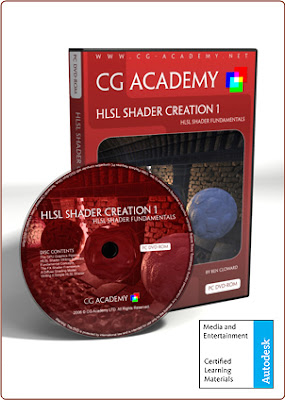HLSL Training DVD
I've been telling game artists for a long time that they need to learn to write shaders in HLSL. Putting in the time to learn a little programming is a very small thing compared to the total control and power you get over the appearance of your art when you can write your own shaders.
Now instead of just telling people to learn, I'm working to help people learn. Chris Thomas from Cg Academy has invited me to create a series of training DVDs for the purpose of teaching artists HLSL. I've already created the first DVD, "HLSL Fundamentals" and it's now available from Cg Academy.
 This first DVD focuses on the basics of shader writting, breaking things down so that you don't have to have any programming experience to start learning to write shaders. You can read all about the content of the first DVD on the Cg Academy site.
This first DVD focuses on the basics of shader writting, breaking things down so that you don't have to have any programming experience to start learning to write shaders. You can read all about the content of the first DVD on the Cg Academy site.
I'm currently working on the second DVD in the series which focuses on lighting in shaders. I'm going to talk about how to add omni lights, directional lights, and spot lights to your shaders, discuss the various elements of surface lighting and shading, and also present some advanced lighting topics.
This is a really fun project to work on, and I hope that the DVDs are helpful to artists who are interested in learning to write shaders in HLSL. If you've seen the first DVD, feel free to leave me some feedback. I'd love to hear from you. I'm also open to suggestions for what to put on future DVDs.
Now instead of just telling people to learn, I'm working to help people learn. Chris Thomas from Cg Academy has invited me to create a series of training DVDs for the purpose of teaching artists HLSL. I've already created the first DVD, "HLSL Fundamentals" and it's now available from Cg Academy.
 This first DVD focuses on the basics of shader writting, breaking things down so that you don't have to have any programming experience to start learning to write shaders. You can read all about the content of the first DVD on the Cg Academy site.
This first DVD focuses on the basics of shader writting, breaking things down so that you don't have to have any programming experience to start learning to write shaders. You can read all about the content of the first DVD on the Cg Academy site.I'm currently working on the second DVD in the series which focuses on lighting in shaders. I'm going to talk about how to add omni lights, directional lights, and spot lights to your shaders, discuss the various elements of surface lighting and shading, and also present some advanced lighting topics.
This is a really fun project to work on, and I hope that the DVDs are helpful to artists who are interested in learning to write shaders in HLSL. If you've seen the first DVD, feel free to leave me some feedback. I'd love to hear from you. I'm also open to suggestions for what to put on future DVDs.
